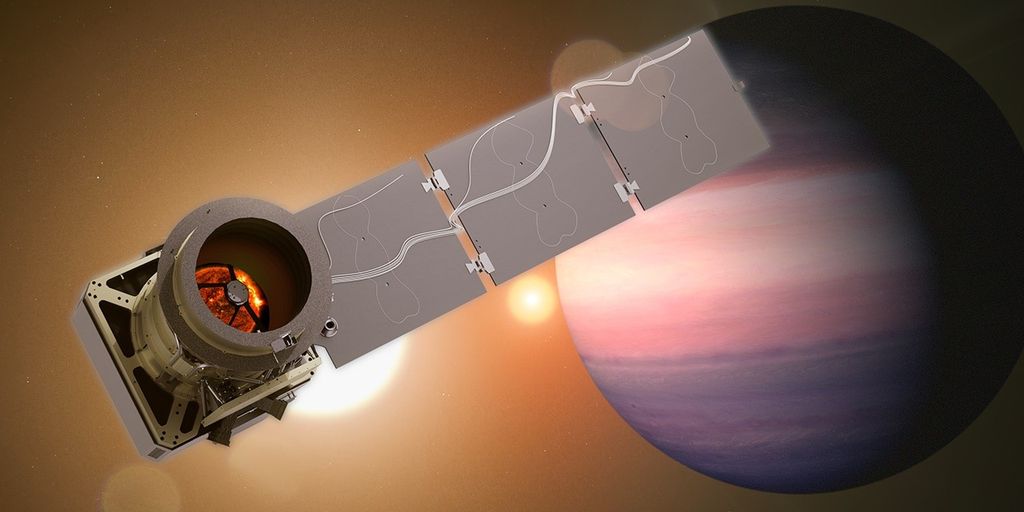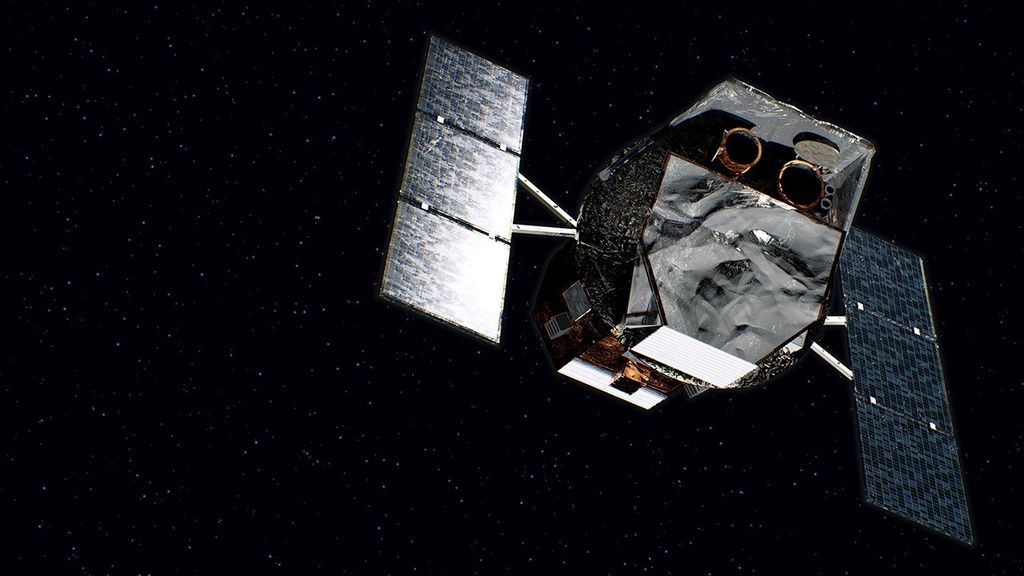1 min read
Rocky Exoplanet TRAPPIST-1 b (Dayside Temperature Comparison)
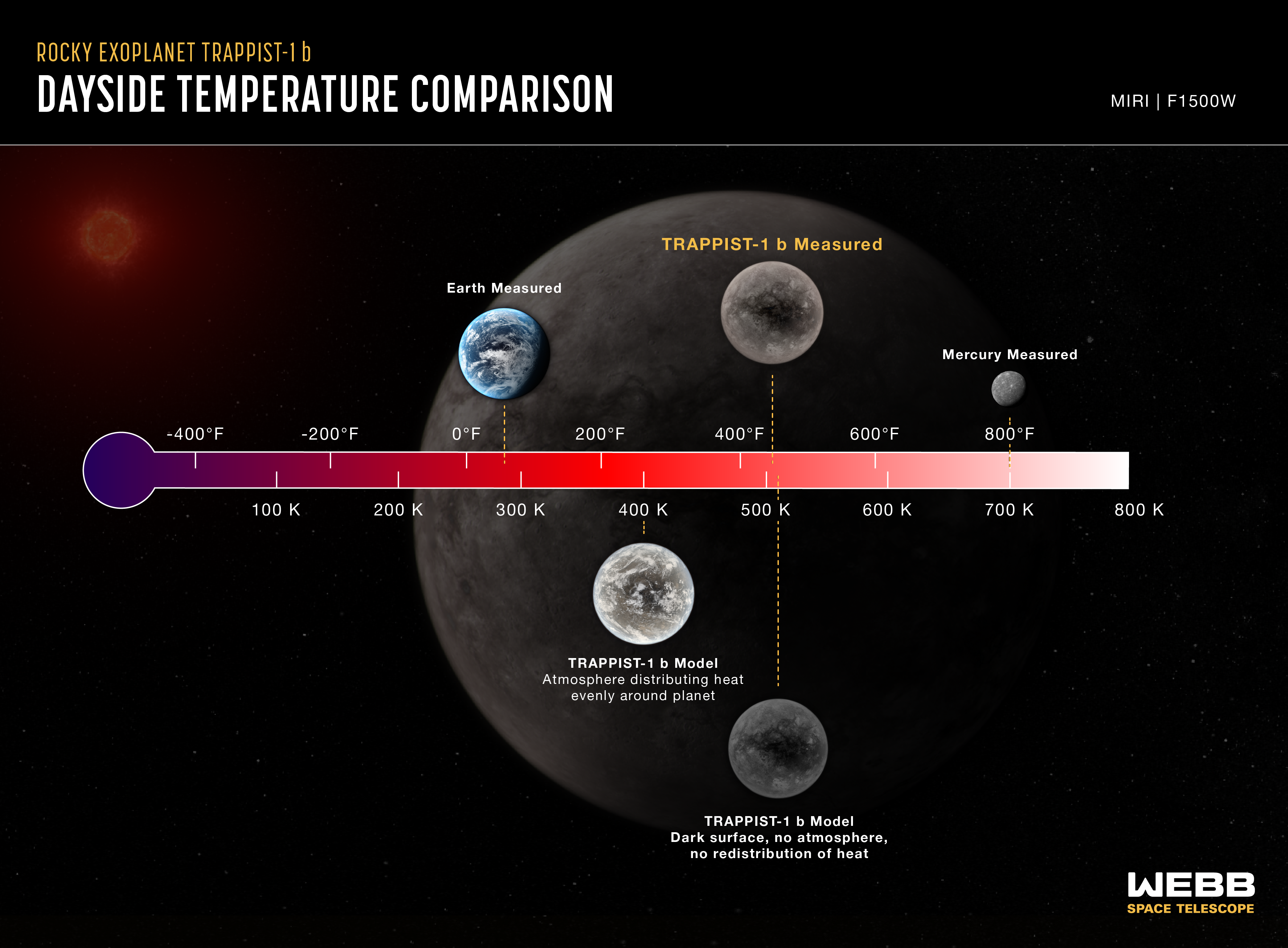
Comparison of the dayside temperature of TRAPPIST-1 b as measured using Webb’s Mid-Infrared Instrument (MIRI) to computer models showing what the temperature would be under various conditions. The models take into account the known properties of the system, including the temperature of the star and the planet’s orbital distance. The temperature of the dayside of Mercury is also shown for reference.
The dayside brightness of TRAPPIST-1 b at 15 microns corresponds to a temperature of about 500 kelvins (roughly 450 degrees Fahrenheit). This is consistent with the temperature assuming the planet is tidally locked (one side facing the star at all times), with a dark-colored surface, no atmosphere, and no redistribution of heat from the dayside to the nightside.
If the heat energy from the star were distributed evenly around the planet (for example, by a circulating carbon dioxide-free atmosphere), the temperature at 15 microns would be 400 kelvins (260 degrees Fahrenheit). If the atmosphere had a substantial amount of carbon dioxide, it would emit even less 15-micron light and would appear to be even cooler.
Although TRAPPIST-1 b is hot by Earth standards, it is cooler than the dayside of Mercury, which consists of bare rock and no significant atmosphere. Mercury receives about 1.6 times more energy from the Sun than TRAPPIST-1 b does from its star.
Extended Description and Image Alt Text
Extended Description
Infographic titled, “Rocky Exoplanet TRAPPIST-1 b Dayside Temperature Comparison, MIRI F1500W showing five planets plotted along a horizontal temperature scale: Earth, TRAPPIST-1 b, Mercury, and two different models of TRAPPIST-1 b.
Temperature Scale
The temperature scale, which resembles a bulb thermometer, is labeled in kelvins along the bottom and degrees Fahrenheit along the top, increasing in temperature from left to right. The temperature scale is colored, ranging from dark purple in the bulb at the left to red in the middle and white at the right. The kelvin scale ranges from 0 to 800, with labeled tick marks every 100 kelvins beginning at 100 K. The Fahrenheit scale ranges from negative 459.67 degrees to positive 980.33 degrees, with labeled tick marks every 200 Fahrenheit degrees, beginning at negative 400 degrees.
Planets
Three planets are plotted above the horizontal temperature scale. From left to right (cooler to warmer):
- A satellite image of Earth’s dayside with clouds, water, and land labeled “Earth Measured” is plotted at about 290 kelvins and 60 degrees Fahrenheit.
- An illustration of the dayside of a rocky planet with a gray surface labeled “TRAPPIST-1 b Measured” is plotted just above 500 kelvins and about 445 degrees Fahrenheit.
- A space probe image of the dayside of Mercury’s gray rocky surface labeled, “Mercury Measured” is plotted at 700 kelvins and 800 degrees Fahrenheit.
Two planets are plotted below the horizontal temperature scale. From left to right (cooler to warmer):
- An illustration of the dayside of a rocky planet with Earth-like cloud features labeled “TRAPPIST-1 b Model: Atmosphere distributing heat evenly around planet” is plotted at 400 kelvins and 260 degrees Fahrenheit.
- An illustration of the dayside of a rocky planet with a dark gray surface labeled “TRAPPIST-1 b Model: Dark surface, no atmosphere, no redistribution of heat” is plotted at about 510 kelvins and 455 degrees Fahrenheit.
Comparison of Planets
Size: TRAPPIST-1 b is slightly larger than Earth. Mercury is very small compared to both Earth and TRAPPIST-1 b.
Temperature: The planet labeled “TRAPPIST-1 b Measured” is plotted at almost the same temperature as “TRAPPIST-1 b Model: Dark surface, no atmosphere, no redistribution of heat,” and a higher temperature than “TRAPPIST-1 b Model: Atmosphere distributing heat evenly around planet.”
TRAPPIST-1 b Measured is plotted almost evenly in between Earth (cooler, to the left) and Mercury (warmer, to the right).
Background
In the background of the graphic is an illustration of a rocky exoplanet and its active red dwarf star. The planet is dark gray with no atmosphere.
Image Alt Text
Infographic titled, “Rocky Exoplanet TRAPPIST-1 b Dayside Temperature Comparison” showing five planets plotted along a temperature scale.
About the Object
- R.A. PositionR.A. PositionRight ascension – analogous to longitude – is one component of an object's position.23h 06m 30s
- Dec. PositionDec. PositionDeclination – analogous to latitude – is one component of an object's position.-05d 02m 30s
- ConstellationConstellationOne of 88 recognized regions of the celestial sphere in which the object appears.Aquarius
- DistanceDistanceThe physical distance from Earth to the astronomical object. Distances within our solar system are usually measured in Astronomical Units (AU). Distances between stars are usually measured in light-years. Interstellar distances can also be measured in parsecs.40 light-years
- DimensionsDimensionsThe physical size of the object or the apparent angle it subtends on the sky.Diameter: 1.1 × Earth; Mass: 1.4 × Earth
About the Data
- Data DescriptionData DescriptionProposal: A description of the observations, their scientific justification, and the links to the data available in the science archive.
Science Team: The astronomers who planned the observations and analyzed the data. "PI" refers to the Principal Investigator.time-series photometry of secondary eclipse
- InstrumentInstrumentThe science instrument used to produce the data.MIRI
- Exposure DatesExposure DatesThe date(s) that the telescope made its observations and the total exposure time.2022: November 8, 12, 20, 24, and December 3
- FiltersFiltersThe camera filters that were used in the science observations.F1500W
- Object NameObject NameA name or catalog number that astronomers use to identify an astronomical object.TRAPPIST-1 b
- Object DescriptionObject DescriptionThe type of astronomical object.Rocky Exoplanet
- Release DateMarch 27, 2023
- Science ReleaseNASA’s Webb Measures the Temperature of a Rocky Exoplanet
- CreditIllustration: NASA, ESA, CSA, Joseph Olmsted (STScI); Science: Thomas Greene (NASA Ames), Taylor Bell (BAERI), Elsa Ducrot (CEA), Pierre-Olivier Lagage (CEA)
Related Images & Videos
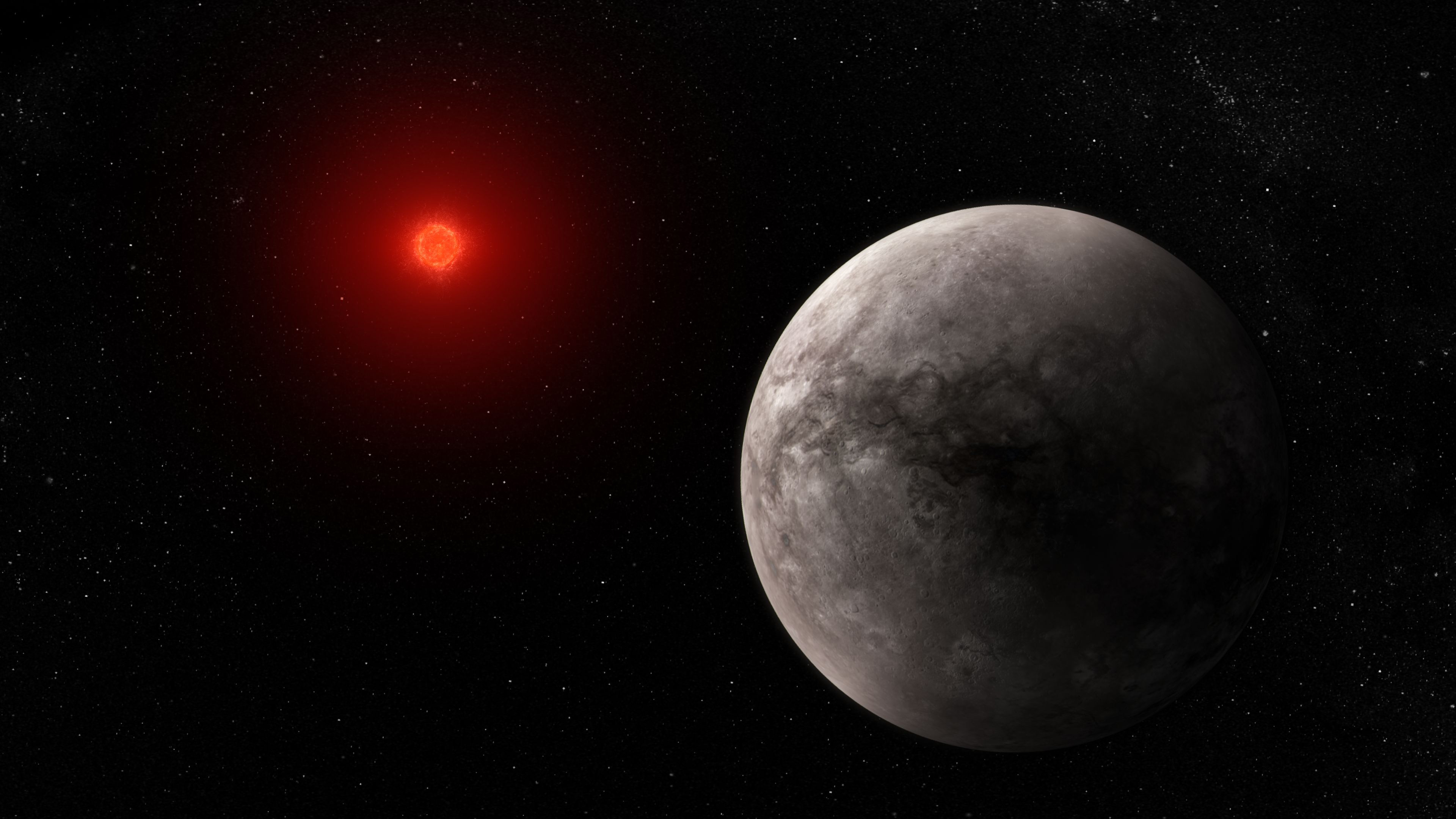
Rocky Exoplanet TRAPPIST-1 b (Illustration)
This illustration shows what the hot rocky exoplanet TRAPPIST-1 b could look like based on this work. TRAPPIST-1 b, the innermost of seven known planets in the TRAPPIST-1 system, orbits its star at a distance of 0.011 AU, completing one circuit in just 1.51 Earth-days....
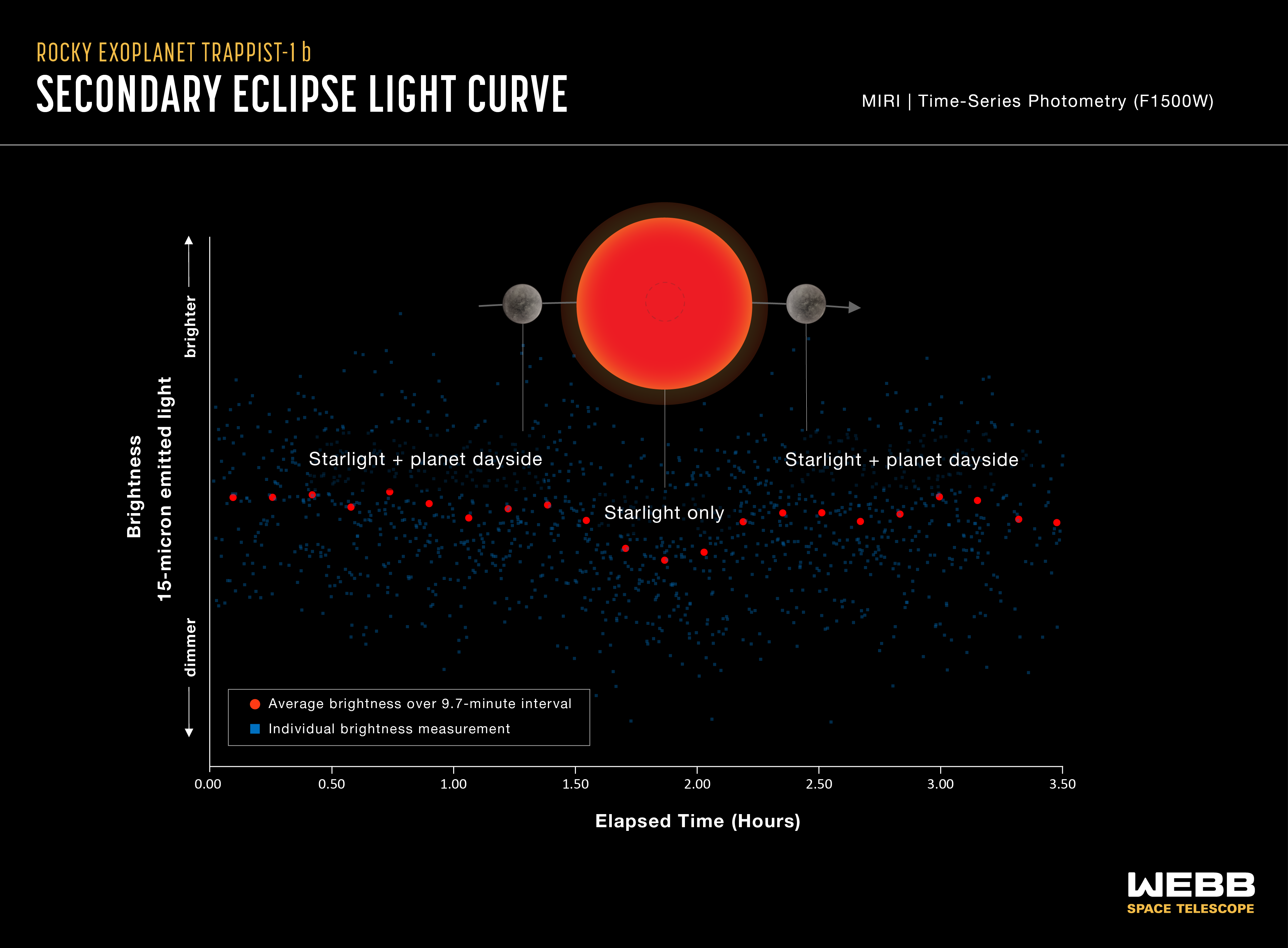
Rocky Exoplanet TRAPPIST-1 b (Secondary Eclipse Light Curve)
This light curve shows the change in brightness of the TRAPPIST-1 system as the innermost planet, TRAPPIST-1 b, moves behind the star. This phenomenon is known as a secondary eclipse . Astronomers used Webb’s Mid-Infrared Instrument (MIRI) to measure the brightness of...
Share
Details
Laura Betz
NASA’s Goddard Space Flight Center
Greenbelt, Maryland
laura.e.betz@nasa.gov
NASA, ESA, CSA, Joseph Olmsted (STScI)
Thomas Greene (NASA Ames), Taylor Bell (BAERI), Elsa Ducrot (CEA), Pierre-Olivier Lagage (CEA)




